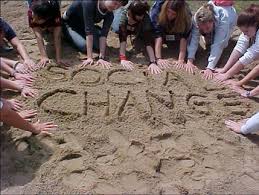 New Orleans has become a pilgrimage of sorts for the nation’s youth. It’s something I’ve come to realize in a big way while researching my new book, Do Greaters: The Kids These Days and How They’re Changing the World. Turns out that for Americans, in general, but especially for folks under 35, New Orleans has become the new rite of passage in our understanding of good works.
New Orleans has become a pilgrimage of sorts for the nation’s youth. It’s something I’ve come to realize in a big way while researching my new book, Do Greaters: The Kids These Days and How They’re Changing the World. Turns out that for Americans, in general, but especially for folks under 35, New Orleans has become the new rite of passage in our understanding of good works.
It’s generally great for the folks who head there. They learn about the complexity of infrastructure, maybe gain a few construction or landscaping skills, meet some new friends, maybe even get a tan. But what is the effect on the native residents of New Orleans?
This is a question I asked in a column over at The American Prospect not too long ago: “Like Juan Ponce DeLeon’s mythological fountain of youth, the Lower 9th Ward has become upper-middle-class America’s source of feel-good absolution….But the darker side of all of this well-intentioned activism is that it has created a revolving door of services and support in a parish that is in dire need of a strategic plan.”
And it’s now being answered by a series of homegrown activists. Some of their answers are chilling, like this one, from Timolynn Sams, executive director of Neighborhoods Partnership Network (NPN), New Orleans native: “We’ve become this laboratory, but we are not guinea pigs. We want to be part of the science, but as the scientists, not the experiment.â€
It brings up all sorts of difficult ethical questions. When are our well-intentioned attempts to help more selfish than selfless? What can folks with big hearts, a little extra money, and a lot of energy do to help rebuild New Orleans? Should we urge all the eager post-college grads to head to Detroit and Cincinnati instead? Or will that just engender the same problems?
Food for thought. Would love to hear your ideas…

 …what of the youth shaped by what some are already calling the Great Recession? Will a publication looking back from 2030 damn them with such faint praise? Will they marry younger, be satisfied with stable but less exciting jobs? Will their children mock them for reusing tea bags and counting pennies as if this paycheck were the last? At the very least, they will reckon with tremendous instability, just as their Depression forebears did.
…what of the youth shaped by what some are already calling the Great Recession? Will a publication looking back from 2030 damn them with such faint praise? Will they marry younger, be satisfied with stable but less exciting jobs? Will their children mock them for reusing tea bags and counting pennies as if this paycheck were the last? At the very least, they will reckon with tremendous instability, just as their Depression forebears did. Richard E. Nisbett, a psychology professor from the University of Michigan, wrote
Richard E. Nisbett, a psychology professor from the University of Michigan, wrote  I’m in the thick of researching and reporting my new book on young people and social change (finally!) and it’s been bringing up all sorts of new and exciting issues for me. Sunday I spent the whole day with a group of New York City high school students who have developed a fascinating project called
I’m in the thick of researching and reporting my new book on young people and social change (finally!) and it’s been bringing up all sorts of new and exciting issues for me. Sunday I spent the whole day with a group of New York City high school students who have developed a fascinating project called